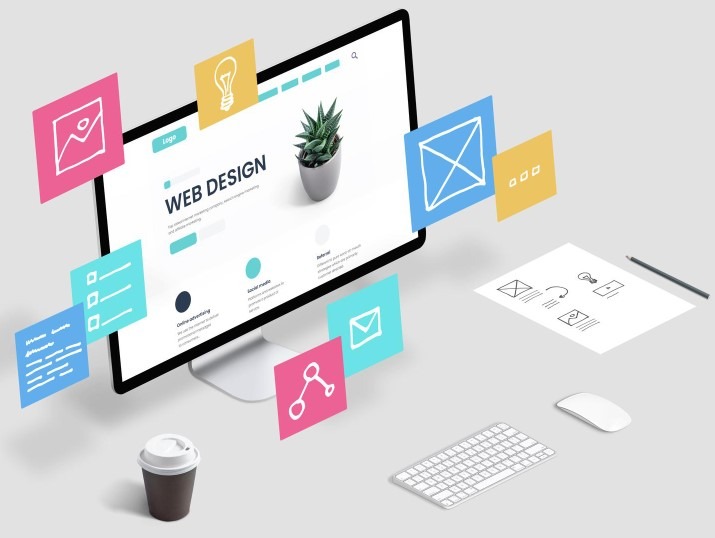Web Design London Ontario with Ranking Strategies and Mobile-Friendly Features
Wiki Article
Understanding the Key Aspects That Make up Efficient Web Style Approaches
Understanding the key components can make all the distinction in individual interaction and complete satisfaction when it comes to web design. You need to ponder facets like instinctive navigation and receptive layout to create a smooth experience. That's simply the beginning. Each component plays a vital role in leading individuals with your material and affecting their behavior. Interested regarding what truly drives these strategies? Let's explore deeper into these essential elements.The Significance of Individual Experience (UX) in Web Style
Customer experience (UX) is the backbone of reliable website design, forming just how site visitors communicate with your site. When you prioritize UX, you develop an area where customers feel comfy, involved, and valued. A well-designed UX assurances that your target market can conveniently navigate your content, locate information quickly, and enjoy their general experience.You needs to consider your individuals' requirements and preferences, as this understanding directly affects their complete satisfaction. By concentrating on elements like tons times, mobile responsiveness, and availability, you improve their experience considerably.Moreover, a favorable UX cultivates trust and motivates repeat visits, which can result in greater conversion prices. Remember, individuals won't think twice to leave your site for a competitor if they encounter disappointment or complication. Inevitably, buying UX isn't nearly visual appeals; it has to do with producing a user-centric design that keeps visitors returning for more.Crafting Instinctive Navigating for Seamless Surfing
When designing an internet site, crafting user-friendly navigation is essential for ensuring visitors can locate what they require without stress. Beginning by organizing your web content rationally; team relevant web pages with each other to aid customers anticipate where to locate info. Usage clear, concise labels for navigating links, avoiding jargon that could perplex your audience.Consider carrying out a hierarchical framework with a primary menu and dropdowns for subcategories, making it very easy to drill down right into certain topics. Integrate a search bar to encourage users to discover content directly, especially on larger sites.Don' t forget mobile customers; identify your navigating stays accessible on smaller displays. Keep it easy and consistent across all web pages to strengthen experience. By concentrating on these components, you'll produce a seamless browsing experience that keeps site visitors involved and urges them to discover even more of what you need to use.Responsive Layout: Adapting to Various Devices
As the selection of devices individuals use to access the internet remains to expand, ensuring your web site is receptive has actually never ever been more important. A receptive style suggests your website adapts seamlessly to different screen dimensions, from mobile phones to desktop computers, providing a superior watching experience. This versatility not only boosts user satisfaction but likewise boosts your website's efficiency in internet search engine rankings.To produce a receptive style, use flexible grids and formats that automatically adapt to the display's measurements. Execute CSS media inquiries to customize designs based upon gadget attributes. Prioritize crucial content, guaranteeing it's quickly obtainable on smaller displays without frustrating customers.The Function of Visual Hierarchy in Effective Layouts
Aesthetic hierarchy is vital for guiding your audience's interest where it matters most. By effectively using focal points, color, comparison, and typography, you can create a layout that connects your message clearly. Allow's check out just how these aspects function together to enhance your design.Significance of Focal Things
Prime focus are necessary in website design, guiding individuals' attention to one of the most important aspects on a page. By strategically placing these focal points, you develop a clear visual power structure that boosts individual experience. Believe regarding what you desire your visitors to observe first-- whether it's a call-to-action switch, a vital photo, or considerable information.Using comparison, size, and positioning, you can attract interest to these prime focus, making them stand out. Keep in mind, the more prominent the centerpiece, the most likely individuals are to engage with it. A properly designed layout not only records passion however also leads individuals with your content flawlessly, ensuring they soak up the details that matters most. Focusing on centerpieces is crucial for reliable interaction on your site.Color and Comparison Use
Effective use color and contrast can substantially influence how customers regard your site's material. By choosing a color scheme that aligns with your brand, you develop a psychological link with site visitors. High comparison in between message and background improves readability, guaranteeing your message sticks out. Usage contrasting shades to highlight crucial aspects, like call-to-action switches, guiding users' attention where it matters most.Additionally, balance is key; way too much contrast can be overwhelming, while also little might make your web content undetectable. Executing a visual pecking order with shade helps customers browse your website with ease. You desire them to conveniently compare headings, subheadings, and body text, which enhances their overall experience. Ultimately, effective shade and comparison use maintains individuals involved and urges them to explore further.
Typography's Effect on Layout
While it's very easy to neglect, typography plays a necessary duty fit your internet site's layout and total customer experience. It develops an aesthetic power structure that overviews site visitors with your content. By choosing the best font styles, dimensions, and styles, you can highlight vital information and develop a smooth circulation. Making use of bigger headings assists customers swiftly determine areas, while smaller sized body text gives in-depth understandings without frustrating them. Consistent typography not just boosts readability yet likewise strengthens brand identification. Bear in mind to stabilize attractive fonts with legibility to keep professionalism and trust. Ultimately, reliable typography warranties your message resonates, making your site extra user-friendly and appealing. Prioritizing this aspect can substantially boost your design method and influence.Making Use Of Compelling Content to Engage Visitors
How can you maintain your visitors involved and returning for even more? The answer depends on compelling content. Start by recognizing your target market and what passions them. Create insightful short articles, enthralling tales, or entertaining videos that website design london Ontario reverberate with their demands. Utilize a conversational tone to make your web content relatable; it should really feel like a pleasant chat instead of a lecture.Incorporate visuals like pictures, infographics, and videos to damage up text and maintain points vibrant. Don't neglect to welcome communication-- ask concerns, urge comments, or consist of polls to trigger discussions.Also, prioritize clearness and conciseness. Make certain your primary factors shine through without unnecessary jargon or fluff. Remember, quality over quantity matters; it's better to have less, high-impact items than a multitude of mediocre ones. Inevitably, when your web content's engaging, site visitors will not only linger but likewise share it with others.The Impact of Shade Psychology on Customer Interaction
Think about exactly how they can affect customer emotions and understandings when you choose colors for your website. Shades can enhance your brand identification while also making certain access through contrast. Understanding these aspects can significantly boost customer communication and involvement.Color Meanings and Emotions
Understanding color psychology is essential for producing an appealing website design, as the colors you choose can evoke specific emotions and affect individual communications. Different colors can cause different sensations; for example, blue commonly conveys trust and peace, while red can evoke enjoyment or seriousness. You guide your individuals towards desired actions when you incorporate these shades attentively. Yellow can inspire optimism and happiness, making it effective for contact us to action, while eco-friendly promotes relaxation and a link to nature. By aligning your shade palette with the emotions you wish to generate, you boost customer experience. Consider your target market and the message you intend to convey, ensuring your shade selections reverberate and create a long lasting impact.Brand Identification Via Colors

Color Comparison and Access
While choosing a color combination is essential, assuring sufficient comparison is important for availability. You desire your site to be visually attractive, yet it must also provide to all users, including those with visual impairments. High comparison between text and history boosts readability, making it easier for everybody to involve with your content.Think regarding color psychology, too. Different shades evoke various emotions and reactions. By comprehending exactly how shades influence individual communication, you can direct individuals toward preferred activities. For circumstances, using warm shades can create seriousness, while trendy colors could instill peace. Always evaluate your shade mixes to validate they meet access standards, aiding you create a comprehensive experience that resonates with all visitors.Maximizing Lots Rate for Boosted Efficiency
Because individuals expect sites to fill rapidly, enhancing lots speed is vital for boosting performance and user satisfaction. A slow-loading website can annoy visitors and drive them away, so you need to act. Begin by pressing photos and making use of modern-day formats like WebP. This can considerably reduce documents dimensions without giving up quality.Next, reduce HTTP requests by integrating CSS and JavaScript data. Fewer demands indicate quicker lots times (website design london Ontario). Carrying out careless loading for images and video clips guarantees that web content tons just when customers scroll down, boosting initial load speed.Additionally, leverage internet browser caching to save often accessed resources, allowing repeat site visitors to appreciate quicker filling times. Pick a trusted hosting company. Their efficiency directly influences your site's speedOften Asked Questions
How Can I Measure the Efficiency of My Internet Layout Technique?
To measure your web layout strategy's performance, track customer engagement metrics like bounce rates, conversion rates, and typical session period. Usage devices like Google Analytics to gather understandings and adjust your approach based upon the data.What Prevail Blunders to Prevent in Website Design?
In website design, avoid chaotic formats, irregular font styles, and slow-moving filling times (website design london Ontario). Do not neglect mobile responsiveness or disregard user testing. Focus on access and guarantee clear navigating to improve user experience and maintain visitors involvedHow Usually Should I Update My Web Site Layout?
You must update your website layout every 1 to 2 years, or whenever significant changes occur in your brand name or industry. Regular updates maintain your website fresh, improve individual experience, and improve capability.
What Equipment Can Help Analyze Individual Habits on My Website?
To evaluate customer actions on your website, you can make use of tools like Google Analytics, Hotjar, or Crazy Egg. They'll offer insights into customer interactions, aiding you make informed decisions for improving your web site's efficiency.
How Do I Select the Right Font Style for My Site?
Selecting the right font for your website includes considering readability, design, and positioning with your brand. Explore various fonts, verify they're legible on different tools, and maintain consistency across your web pages for a cohesive appearance. Incorporate a search bar to equip customers to discover content directly, particularly on bigger sites.Don' t neglect concerning mobile customers; identify your navigation remains easily accessible on smaller sized displays. Efficient usage of color and contrast can considerably affect just how customers regard your website's web content (website design london Ontario). Recognizing color psychology is vital for creating an appealing internet layout, as the shades you choose can stimulate certain emotions and influence individual communications. By understanding just how shades influence individual communication, you can lead customers towards preferred activities. Considering that customers anticipate websites to pack swiftly, maximizing load rate is critical for improving efficiency and user satisfactionReport this wiki page